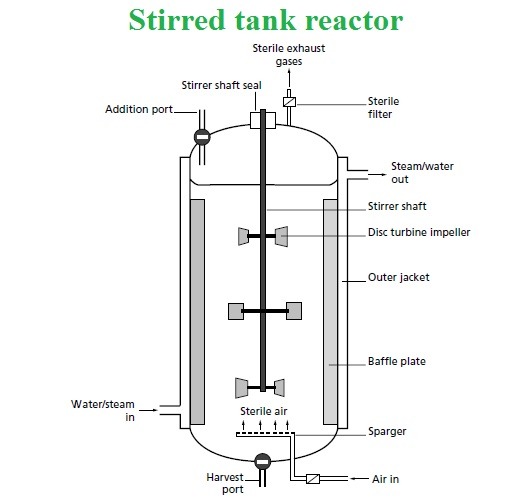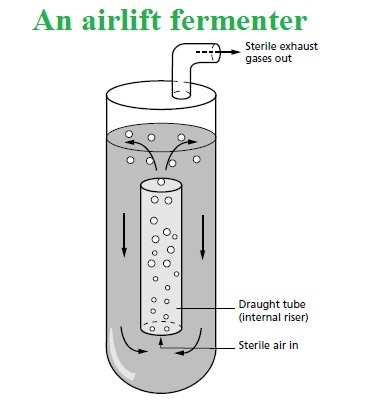Overview of bioreactor or fermenters
Contents
- Introduction
- History
- Function
- Design
- Classifications
Introduction
- It is a device or system that used to support biologically active environment.
- It is a system within which substrate of very low value is employ by living cells or enzymes to produce a product of greater value.
- A fermenter is a closed system vessel which have an adequate provision for temperature, agitation, aeration, pH control, and drain or overflow vent to remove waste biomass of culture microorganism with their products.
History
- In 1944 De becze and Liebmann used the primary large-scale fermenter for the growth of yeast.
- But, during the time of world war there’s is a British scientist whose name is Chain Weizmann who desigined a fermenter for the production of acetone.
Functions
- It should have a provision to control environment for optimum biomass or product yield.
- It should provide an aseptic fermentation condition for more reliablity.
- It should provide the adequate or proper mixing and aeration for the growth and production without damaging of the microorganisms or cells.
- It should have a system temperature control.
- It should have a system to monitor and regulate pH of the fermentation broth.
- Facility for sampling should be provided.
- It should have required minimum of labour in maintenance, cleaning, operating and harvesting operation.
Design
A bioreactor should consist of the followings:
- Agitation- for mixing of cells and medium.
- Aeration – aerobic fermentation used for oxygen supply.
- Temperature
- pH, pressure, nutrients feeding, etc.
- Sterilization and maintenance of sterility.
- Withdrawal of cells or media.

Agitation and Aeration
- Agitations are aims to ensure similar distribution of microorganisms and the nutrients in the broth.
- Aeration to provide microorganisms growing in submerged culture with adequate oxygen supply.
The following components of the fermenter which is required for aeration and agitation:
- Agitator (impellers)
- Stirrer glands and bearings
- Baffles
- Sparger (the Aeration system)
Agitator (Impellers)
- It is of several different type:
-
- Disc turbine
- Vaned disc turbine
- Open turbine
- Propeller
- It achieves the following objective:
- Bulk mixing
- Air dispersion
- Oxygen transfer
- Heat transfer
- Maintain uniform environment
Stirrer glands and bearings
- It provides for maintaining aseptic conditions over a long period.
Four basic types of seals used in fermenters are:
-
- Stuffing box
- Simple bush seal
- Mechanical seal
- Magnetic drive
Baffles
- It is metal strips.
- One tenth of the vessels diameter.
- Attached radially to fermenters wall.
- It provided to prevent vortex formation and improve efficiency.
Aeration system (Sparger)
- It introduces air into the fermenters broth.
It is of three types:
-
- Porous Sparger
- Orifice Sparger
- Nozzle Sparger
Temperature control: adequate provision for control of Temperature.
Pressure gauge: It measures pressure inside the fermenters.
pH probe: It provides to measure and monitor pH of the medium.
Inlet air filter: Provision to supply air in the fermenters.
Exhaust air filter: Provision to drain out the air from the fermenters.
Cooling jacket: Provided to maintain the temperature of the fermenters throughout the process.
Control panel: it monitors all the parameters.
Foam control: it is produced during most microbial fermentation. Antifoams are used to removes foam from the surface of media e.g., silicone, soybean oil, cotton seed oil, sulphonate etc.
Classifications
- On the basis of agent used, bioreactors are of two types:
-
- On the basis of living cells
- On the basis of enzymes employed
- In the terms of process fermenters, is of following types:
-
- Aerobic
- Anaerobic
- Solid state
- Immobilized cell disruption
Types of fermenters
- Fermenters are of 4 types:
-
- Stirred tank reactor
- Airlift fermenters
- Tower fermenters
- Bubble up fermenters
Stirred tank reactor

- Smaller vessel is made up of glass while, lager vessels are made up of stainless steel of 1-1,000 or even 8,000L.
- They are closed system in which volumes are fixed.
- They are agitated with motor driven stirrer’s.
- It is a kind reactor with continuous flow culture system which is either of chemostat or turbidostat type.
Airlift fermenters
- It comprises of a gas light baffled riser tube or drought tube which is connected to the downcomer tube.

It is of two types:
-
- Internal- loop airlift bioreactor
- External loop airlift bioreactor
- These type of fermenters are commonly employed for aerobic bioprocessing technology.
- Because of their high efficiency, it is mostly preferred for production of methanol and SCP, etc.
Tower fermentation
- It was defined by Greenshields and co-workers.
- It is an elongated non-mechanically type of fermenters.
- There is unidirectional gases flow throughout the bioreactors.
Tower fermenters are of following types:
-
- Bubble columns
- Vertical tower beer fermenters
- Multistage fermenters
Bubble up fermenters
- It is a bubble columns fermenters which havee an internal cooling coil.
- Air is introduced from the bottom of the column.
Reference and Sources
- 1% – https://wiki2.org/en/Bioreactor
- 1% – https://samacheerkalvi.guru/author/bhagya/page/9/
- 4% – https://www.slideshare.net/shmpanwar92/bioreactors-fermenters-56475754
- 2% – https://senthilarivan.wordpress.com/2015/11/26/fermenter-and-its-features/
- 1% – https://www.dedot.info/airlift-fermenters-17/
Also Read:
- Overview of Microbial Growth control
- Water as a Microbial Habitat
- Influence of Environmental Factors on Microbial Growth
- Endospore staining and capsule staining of the bacteria
- CRISPR-Cas9 Gene editing tool: Introduction, Principles, Uses & Applications
